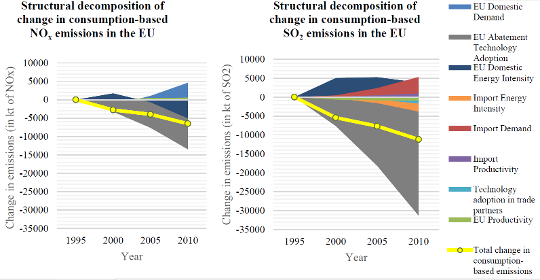Decomposition of SO2 and NOx emissions in the EU: Leakage or technology adoption?
Introduction
Europe has made remarkable progress in reducing its emissions of SO2 and NOx. Using consumption-based emissions in the EU27 countries over the period 1995-2010, this research investigates if this reduction has been due to adoption of pollution abatement technology or to a relocation of production to other regions.
Methodology
Consumption-based emissions are calculated via integrating emissions data from the GAINS model and input-output table from the World Input-Output Database [1]. Through a structural decomposition analysis, emissions embodied in trade are segregated as those that occur through a change in final demand, an increase in productivity, energy intensity, or adoption of abatement technology.
Results
First, consumption-based emissions in the EU have been decreasing. The structural decomposition analysis found that a decrease in emissions factor from application of abatement technology within the EU has contributed to most of this decrease as shown in Figure 1.
Conclusions
This research finds that a decrease in SO2 and NOx emissions in the EU is primarily due to an implementation of abatement technology. In contrary to existing literature on emissions leakage [2] we found that demand for both EU production and EU import increases. An increase in energy intensity in domestic EU production has a positive effect on emissions, while a decrease in energy intensity in imports to the EU contributes to the decrease in emissions.
References
[1] Timmer, M. et al. (2012). The World Input-Output Database (WIOD): Contents , Sources and Methods.
[2] Balistreri EJ, Rutherford TF (2012). Subglobal carbon policy and the competitive selection of heterogeneous firms. Energy Economics, 34, S190–S197. doi:10.1016/j.eneco.2012.08.002.
Supervisors
Lena Höglund Isaksson and Wolfgang Schöpp, Mitigation of Air Pollution and Greenhouse Gases, IIASA
Note
Thanicha Ruangmas of the Department of Agricultural and Applied Economics, University of Wisconsin-Madison, USA, is a citizen of Thailand. She was funded by IIASA’s Annual Fund and worked in the Mitigation of Air Pollution and Greenhouse Gasses (MAG) Program during the YSSP.
Please note these Proceedings have received limited or no review from supervisors and IIASA program directors, and the views and results expressed therein do not necessarily represent IIASA, its National Member Organizations, or other organizations supporting the work.



